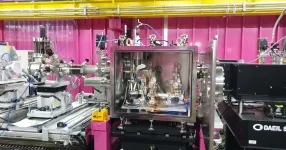INFORMATION:
This research was conducted with the support from the Development of Accelerator-Based Core Technology Program, Mid-career Researcher Program, and the Science Research Center Program of the National Research Foundation of Korea. The research findings were recently introduced in the online edition of ACS Nano and will soon be published in the print version.
Filming a 3D video of a virus with instantaneous light and AI
2021-03-03
(Press-News.org) It is millions of trillions of times brighter than the sunlight and a whopping 1,000 trillionth of a second, appropriately called the instantaneous light. It is the X-ray Free Electron Laser (XFEL) light that opens a new scientific paradigm. Combining it with AI, an international research team has succeeded in filming and restoring the 3D structure of nanoparticles that share structural similarities with viruses. With the fear of a new pandemic growing around the world due to COVID-19, this discovery is attracting the attention among academic circles for imaging the structure of the virus with both high accuracy and speed.
An international team of researchers from POSTECH, National University of Singapore (NUS), KAIST, GIST, and IBS have successfully analyzed the structural heterogeneities in 3D structures of nanoparticles by irradiating thousands of nanoparticles per hour using the XFEL at Pohang Accelerator Laboratory (PAL) in Korea and restoring 3D multi-models through machine learning. The research team led by Professor Changyong Song and Ph.D. candidate Do Hyung Cho of Department of Physics at POSTECH has driven the international research collaboration to realize it.
Nanoparticles have a peculiar function that may not be available from native bulk materials, and one can control their physical and chemical properties by designing 3D structures and compositions of constituting elements.
The commonality between nanoparticles and viruses is that they exist in the form of independent particles, rather than in crystal-regular, periodic arrangements, and, as such, their structures are not uniform at the nanometer level. To precisely understand their structures, it is necessary to statistically analyze the structure of individual particles using the whole ensemble distribution of structures from thousands to hundreds of thousands of specimens. However, electron microscopes often fall short of providing enough penetration to limit the size of the sample to be probed; conventional X-rays may damage the sample by X-ray radiation itself, making it difficult to obtain sufficient resolution.
The research team overcame the practical limitations of the conventional method by using the X-ray free electron laser and the machine learning method to observe the statistical distribution of the 3D structure of thousands of nanoparticles at the nanometer level. As a result, 3D structures of nanoparticles having a size of 300 nm were obtained with a resolution better than 20 nm.
This achievement was particularly significant for restoring the 3D structure of thousands of nanoparticles using machine learning. Since conventional single-particle imaging techniques often assume an identical 3D structure of the specimens, it was difficult to restore the structure in actual experimental data where the sample structure is not homogeneous. However, with the introduction of the multi-model this time, the researchers succeeded in restoring the representative 3D structures. This research has enabled the classification of nanoparticles into four major shapes, and confirmed that about 40% of them had similar structures.
In addition, through quantitative analysis of the restored 3D structure, the international research collaboration team also uncovered the internal elastic strain distribution accompanied by the characteristic polyhedron structure of the nanoparticles and the inhomogeneous density distribution.
"These findings enable the observation of 3D structure of noncrystalline viral specimens with inhomogeneously distributed internal molecules," explained Professor Changyong Song of POSTECH. "Adding the 3D image restoration algorithm to this through machine learning shows promise to be applicable to studies of macromolecule structures or viruses in living organisms."
ELSE PRESS RELEASES FROM THIS DATE:
Periodontitis: Researchers search for a new active substance
2021-03-03
Targeted, efficient and with few side effects: A new method for combating periodontitis could render the use of broad-spectrum antibiotics superfluous. It was developed and tested for the first time by a team from Martin Luther University Halle-Wittenberg (MLU), the Fraunhofer Institute for Cell Therapy and Immunology IZI and Periotrap Pharmaceuticals GmbH. The aim is to neutralise only bacteria that cause periodontitis while sparing harmless bacteria. The study appeared in the Journal of Biological Chemistry.
Periodontitis is a common bacterial inflammation of the gums. According to the World Health Organization WHO Oral ...
Vaccine shows signs of protection against dozen-plus flu strains
2021-03-03
Ask Eric Weaver about pandemics, and he's quick to remind you of a fact that illustrates the fleeting nature of human memory and the proximal nature of human attention: The first pandemic of the 21st century struck not in 2019, but 2009.
That's when the H1N1/09 swine flu emerged, eventually infecting upwards of 1.4 billion people -- nearly one of every five on the planet at the time. True to the name, swine flus jump to humans from pigs. It's a phenomenon that has been documented more than 400 times since the mid-2000s in the United States alone.
"They're considered the great mixing vessel," said Weaver, associate professor of biological sciences at the University of Nebraska-Lincoln. "They're susceptible to their own circulating ...
Hassles with child car seats linked to unsafe child passenger behaviors
2021-03-03
Parents who reported more hassles using a child car seat or booster seat - such as the child is uncomfortable or having to make multiple trips in a day - were less likely to follow recommendations from the American Academy of Pediatrics (AAP) on child passenger safety, according to a study published in the journal Academic Pediatrics.
Researchers obtained information about transportation safety behaviors and 20 hassles when using child car seats among 238 socioeconomically and racially diverse parents of children 1 to 10 years of age. Eighty percent of parents reported at least a little bit of a problem with one ...
Drug target could fight Parkinson's and Alzheimer's disease
2021-03-03
Neurodegenerative disorders such as Parkinson's and Alzheimer's disease are in the firing line after researchers identified an attractive therapeutic drug target.
An international collaboration, co-led by University of Queensland researchers, has isolated and analysed the structure and function of a protein found in the brain's nerve fibres called SARM1.
Dr Jeff Nanson said the protein was activated when nerve fibres were damaged by injury, disease, or as a side effect of certain drugs.
"After a damaging incident occurs, this protein often induces ...
How 'green' are environmentally friendly fireworks?
2021-03-03
Fireworks are used in celebrations around the world, including Independence Day in the U.S., the Lantern Festival in China and the Diwali Festival in India. However, the popular pyrotechnic displays emit large amounts of pollutants into the atmosphere, sometimes causing severe air pollution. Now, researchers reporting in ACS' Environmental Science & Technology have estimated that, although so-called environmentally friendly fireworks emit 15-65% less particulate matter than traditional fireworks, they still significantly deteriorate air quality.
Fireworks displays can cause health problems, such as respiratory ailments, because they ...
Dietary fats interact with grape tannins to influence wine taste
2021-03-03
Wine lovers recognize that a perfectly paired wine can make a delicious meal taste even better, but the reverse is also true: Certain foods can influence the flavors of wines. Now, researchers reporting in ACS' Journal of Agricultural and Food Chemistry have explored how lipids -- fatty molecules abundant in cheese, meats, vegetable oils and other foods -- interact with grape tannins, masking the undesirable flavors of the wine compounds.
Tannins are polyphenolic compounds responsible for the bitterness and astringency of red wines. Wine testers have noticed that certain foods reduce these sensations, improving the flavor of a wine, but scientists aren't sure why. Some studies have ...
Stroke risk highest among American Indian people, with or without AFib
2021-03-03
DALLAS, March 3, 2021 -- American Indian people with atrial fibrillation (AFib) had the highest risk of non-hemorrhagic stroke when compared with people in other racial and ethnic groups, and they also experienced the highest overall risk for stroke even without atrial fibrillation (AFib), according to new research published today in the Journal of the American Heart Association, an open access journal of the American Heart Association.
"In previous research, we have confirmed that American Indian individuals, when compared with those in other racial or ethnic groups, have the highest risk of atrial fibrillation, which is a quivering or irregular heartbeat that can substantially increase the risk of blood clots and stroke," said lead study ...
County where people live may predict some cardiovascular death by race, ethnicity
2021-03-03
DALLAS, March 3, 2021 -- The association between race and ethnicity and specific characteristics of some U.S. counties may have a significant impact on death rates related to cardiovascular disease, according to new research published today in the Journal of the American Heart Association, an open access journal of the American Heart Association.
Cardiovascular disease is the leading cause of death in the U.S. across all racial and ethnic groups, and disparities in cardiovascular outcomes for racial and ethnic minority groups have been documented extensively. This study presents a detailed analysis of county-level predictors of cardiovascular ...
Origin of childhood cancer malignant rhabdoid tumour discovered
2021-03-03
The first proof of the origin of malignant rhabdoid tumour (MRT), a rare childhood cancer, has been discovered by researchers at the Wellcome Sanger Institute, the Princess Máxima Center for Pediatric Oncology in the Netherlands, and their collaborators.
The study, published today (3 March 2021) in Nature Communications, found that MRT arises from developmental cells in the neural crest* whose maturation is blocked by a genetic defect. The team also identified two drugs that could be used to overcome this block and resume normal development, bringing hope of new treatments for the disease.
Malignant rhabdoid tumour (MRT) is a rare soft tissue cancer that predominantly affects infants. ...
Automated next generation sequencing platform can accurately screen thousands for COVID-19
2021-03-03
A robotics platform designed by Toronto researchers to screen thousands of COVID-19 samples at once has the potential to revolutionize how labs track the spread of viruses and other pathogens, according to new findings.
The END ...



